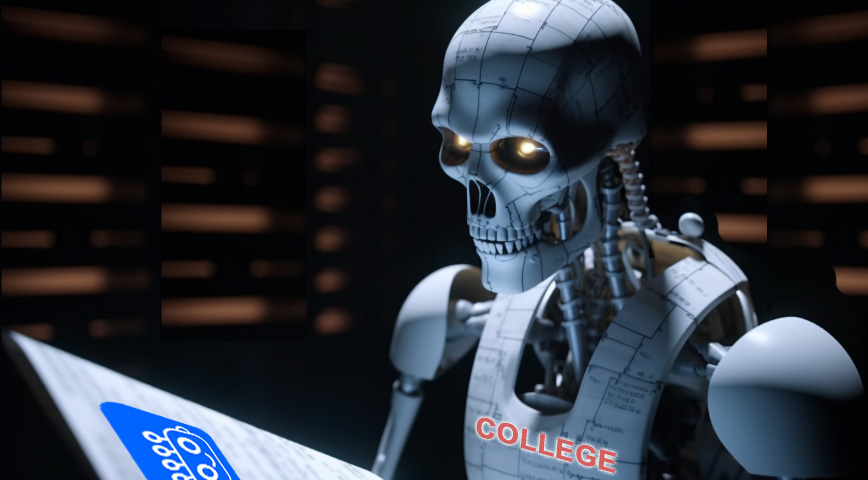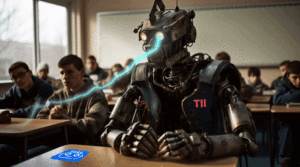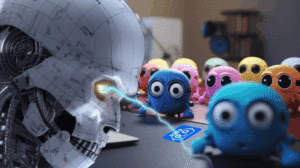Tell you what, slapping together a college essay is no picnic. It gets even stickier when you’re in a cold sweat over that million-dollar question, can colleges detect AI writing?
Sure, AI writing tools seem like a magic wand, helping students whip up essays in no time. But then, there’s that gnawing question – is the college going to red-flag your work as swiped or churned out by a machine?
With all the whispers about AI writing, and new products like Turnitin’s AI Writing Detector, it’s super crucial for college students to get the scoop on how universities are spotting cheaters with machine help.

Try these new AI-powered tools:
- 5 Best AI Detectors To Unmask AI-Written Content With Accuracy
- 5 Best AI Writers To Boost Your Productivity And Content Quality.
- This "Secret AI Writer" Can Bypass AI Detection Like A Pro.
So, if you’re a student, perk up, ’cause this article’s got your name on it. You’ll get the skinny on the kinds of tools universities use to catch AI writing, the shake-up it could give education, the ethics to chew over, and a heap more.
This article is your secret weapon, helping you figure out the difference between human-crafted and AI-spun writing. Dive in for more.
Article At-A-Glance
-
- Schools are up to their eyeballs, trying to flag down AI-spun writing and cooking up ways to clamp down on scholarly shenanigans.
- Researchers are burning the midnight oil, devising smart techniques, including cheat-detection software, to spot AI-spun content in student submissions.
- It’s majorly important to probe the ethical side of AI writing in education, focusing on issues like authenticity, the spread of fake news, and guarding privacy.
- To steer through the storm of AI writing in education, universities need to roll out and regularly refresh rules and regulations that help them harness the positives and fend off the downsides.
Table Of Contents
Can Colleges Detect AI Writing?
In our day and age, where new tech keeps popping up like popcorn, a wave of ethical hang-ups rises along with them.
In the world of academia, a major worry looms as colleges are hot on the trail of ways to spot AI-spun writing in student work.
So, can colleges sniff out AI writing?
Worries About AI Writing Tools
When you think about using artificial intelligence (AI) writing tech in the classroom, schools are sweating over possible issues of academic honesty.
Scholars reckon that student essays written using AI tools have a structure and content that anti-plagiarism software like Turnitin can spot from a mile off, making it hard or downright impossible for students to pass off swiped work as their own.
On the flip side, there are whispers about how advanced these AI techniques are getting, and whether they can really pass their work off as human-written.
ChatGPT is one such smarty-pants tool, designed to lend a hand with school assignments – a chatbot armed with GPT-4 that can crank out whole papers based on keywords given by its user.
This is making teachers and school bosses jittery, with worries that students could churn out a ton of ideas all at once, pumping out papers without putting in any real research or critical thinking.
There are worries about what could happen if AI tech keeps on advancing, with no new ground rules for how it’s used in education.
Plagiarism-Detection Software Demand Skyrockets
Cheat-detection software has shot up the charts as an ace up the sleeve for schools to tackle AI-sourced plagiarism.
Created with the express purpose to sniff out and flag AI-spun work, this tech uses algorithms fired by natural language processing to track down AI-spun content.
By matching a student’s assignment or essay against online sources in its mammoth database, these tools are speedy at scanning for any copy-paste cases or similar writing patterns and styles that could point to cheat sheet use.
By matching a student’s assignment or essay against online sources in its mammoth database, these tools are speedy at scanning for any copy-paste cases or similar writing patterns and styles that could point to cheat sheet use.
What’s more, a bunch of these programs come with fancy text analysis skills designed to spot any weird bits like sentences that don’t follow or repeated phrases that could’ve been churned out by a chatbot.
So, does this mean that colleges can catch AI writing?
Spotting Assignments Whipped Up By AI Writing Tools
Spotting assignments whipped up by AI writing tools is a real head-scratcher for universities and educators, even with cheat-detection software in the picture.
AI writing tools are getting smarter by the minute, making it a tall order to tell AI-spun text from human writing without the help of souped-up software and detection tricks.
Turns out, Turnitin’s a bit of a dud when it comes to spotting assignments whipped up by AI writing tools. Edward Tian, a top-dog senior at Princeton University has cooked up an app that can catch text written by ChatGPT – a widely-used chatbot built on GPT-3 tech – but this can only be pegged as AI with some manual poking around.
The cooking up of such apps just goes to show the sticky wicket we’re in, telling the difference between the real McCoy human writing and AI-spun content.
This cranks up the heat on ethical questions around scholarly dishonesty and needs schools to spring into action against cheating to keep the bar high for integrity across higher ed programs.
Hiccups In Detecting AI Writing In Colleges
AI detection tech isn’t foolproof and runs the risk of crying wolf. In other words, it could give the thumbs-up to AI-spun texts as non-AI when they’re actually the work of AI. That’s a sweet deal for the students.
But then, there’s the flip side of getting it wrong. These possible outcomes of AI detection software could throw both the school and the student under the bus.
False Alarms And Misses
Let’s dig deeper into the false alarms and misses. These are slip-ups in spotting swiped content.
False alarms pop up when human-spun texts are red-flagged as bot-produced when they’re really not. This is a real worry, especially when we’re trying to figure out if student assignments are legit.
On the other hand, misses can be just as troubling. Getting it wrong and marking AI-spun text as human-written could let scholarly dishonesty slide by.
Research by OpenAI flags up worries about messing up and labeling AI-spun text as human-written, which could mean handing out credit where it’s not due, or letting students claim they wrote something they didn’t.
AI Models In Overdrive
No two ways about it, AI models are on a roll, getting sharper by the day. This means the quality of AI-spun writing gets better as tech leaps ahead.
That said, colleges are finding it tougher to spot if an assignment’s been whipped up by a chatbot, an AI program, or a real-life human.
Computer whizzes the world over are burning the midnight oil, tuning AI writers to sound more human, which can ramp up the false alarms for AI-detection software.
On top of that, they’re also rustling up new tricks to bump up the hit rate when sniffing out assignments cranked out by ChatGPT or other similar programs.
With these nifty tools becoming handier by the minute, the risk of them being used for no good in academic settings rises – setting off a heap of ethical brain-benders and challenges that need nipping in the bud.
Privacy Worries For Student Data
AI writing tools have hit the panic button on student data privacy. AI-fueled solutions need a truckload of data to learn and get better, meaning they often need to scoop up, store, and share user info between vendors.
What’s more, students may not have a say in who peeks at their work.
Take this, for instance, a bunch of commercial cheat-spotting services let third-party outfits take a gander at submitted papers to double-check them while keeping student identities under wraps. This means that third parties could be using personal info without students being any the wiser.
To fend off these threats, policymakers need to make sure sturdy security safeguards are in place, as well as lay down the law on how user data should be handled when using AI writing tools in school settings.
Plus, since these databases are stashed in the cloud, there’s a bigger risk of security slip-ups which could spill sensitive docs containing private info about themselves or others they’ve written with.
To fend off these threats, policymakers need to make sure sturdy security safeguards are in place, as well as lay down the law on how user data should be handled when using AI writing tools in school settings.
The Shake-Up From AI Writing In Education
AI writing could shake things up in education, for better or for worse, making it a hot potato.
It could also trip up students who lean on it too much and don’t know how to play it smart.
Opening The Door To Scholarly Dishonesty
Students using AI writing tools could nose ahead of their classmates if they’re able to hand in snazzier work than those who don’t have these tools at their disposal.
What’s more, some students see using these types of tools as a sneaky way to get ahead and try to pass it off as their own work, even when they know it’s not above board.
While colleges and high schools could spot plagiarism using software, it might not always hit the mark when it comes to assignments whipped up by AI.
In a nutshell, they might get it wrong, either way, crying wolf or missing the mark when trying to sniff out scholarly dishonesty, since leaning only on automated systems could put the kibosh on their ability to spot AI-spun coursework from crafty AI writing tools.
Ethics And All That Jazz
Using AI in the old classroom kicks up a whole bunch of ethical brain scratchers that need to be tackled by teachers and students alike. One biggie that’s got folks talking is about how AI impacts the authenticity and originality of students’ work, which colleges or future bosses often prize for credibility’s sake.
Plus, gizmos like ChatGPT have stirred the pot with their dicey reliability and potential to scatter false info via automated replies.
When thinking over the use of AI-spun text in scientific research, ethical pieces of the puzzle like transparency, bias, informed consent, and privacy need to be weighed up and measured before anyone hits the go button.
These implications can get particularly thorny when we’re talking about tech that relies a lot on machine learning algorithms chewing on sensitive educational data sets.
Teachers should also get the lowdown on both the potential upsides and downsides tied to using AI in teaching while setting smart policies around how it’s rolled out in educational settings.
Time For A Policy Tune-Up
AI writing tools bring up a heap of issues around academic integrity, plagiarism, and pulling a fast one. Schools need to hold the line in this area.
But at the same time, they also have to tackle wider ethical puzzles such as privacy worries.
To pull this off, they need to freshen up their policies and draw up rules that shield against the misuse of AI tech in education, especially when it’s used to cheat or copy assignments.
The Bright Side Of AI In Education
AI in education comes with a bundle of potential goodies, especially for teachers. It can take care of the dull-as-dishwater tasks and free up their time.
It can also bridge the educational gap by offering tailor-made learning experiences for students across the globe.
AI-fueled skills like voice recognition, facial recognition, natural language processing, and machine vision tech have been put to use to give students a leg up in various areas of their studies.
This can also keep tabs on class attendance data and sift through assignments or performance on specific measures to track learning progress.
What’s more, it’s being used to offer more customized learning experiences based on student behavior and interests.
By sifting through individual likes and dislikes, AI can cook up tailor-made content that’s a much better fit for students’ needs than traditional methods.
What Lies Ahead
AI-aided writing software could potentially pave the way for fake news or tweaking text to spread false info.
Aside from worries about academic trickery and privacy snags, there are also implications in terms of future policy-making around spotting AI-spun content by colleges.
So, smoothly fitting AI writing tools or other AI-aided tools into the classroom means there’s a more urgent need for fresh policies and rules around how they’re used.
So, smoothly fitting AI writing tools or other AI-aided tools into the classroom means there’s a more urgent need for fresh policies and rules around how they’re used.
This way, schools can head off potential hazards while making the most of the benefits of AI writing.
Finding The Way Through The Impact Of AI Writing In Higher Education
AI writing’s set to shake things up big time in higher education. Universities need to stay one step ahead and put rules in place to check if this tech’s being used to pull a fast one academically.
Pouring more money into cheat-spotting software, better guidelines for professors, and spruced-up ethical policies are all moves that can be made ahead of time.
On top of that, AI could potentially play a key role in making learning more efficient by letting students pick up knowledge faster and in more depth than ever before possible.
In the final analysis, AI needs to be seen as both an opportunity and a challenge when it comes to institutions of higher learning.
If they can spot it, it should come with the responsibility of making things better to dodge causing damage that can’t be undone.
Meet our resident tech wizard, Steve the AI Guy. Now, before you get any wild ideas, let’s clear up one thing – he’s 100% human! I mean, he’s got the work history to prove it. He spent a decade diving into the deep end of the tech industry doing business intelligence work, splashing around with two of the world’s largest business consulting companies, Deloitte and Ernst & Young. Learn More










